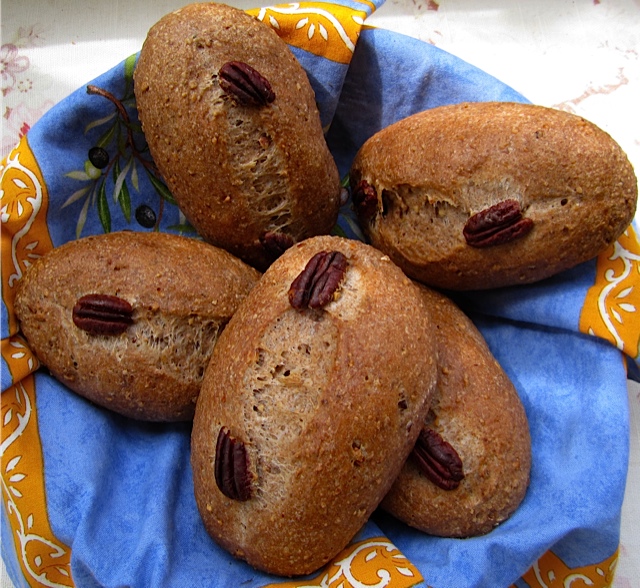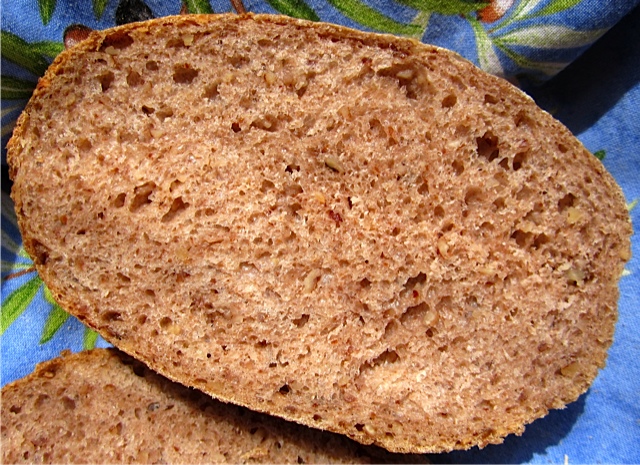
Pecan Breads
PECAN OR HAZELNUT MINI BREADS (6 - 8)
340 g water (95 F)
6 g instant yeast
100 g rye flour
50 g spelt flour
350 g Italian 00 flour*)
10 g salt
5 g sugar
150 g pecans or hazelnuts, toasted
1 egg , for egg wash
10 g water, for egg wash
pecan halves or whole hazelnuts, for decoration
*) can be substituted with pastry flour, but NOT with all-purpose flour!
DAY 1
Dissolve yeast in warm water. Grind nuts together with sugar and 50 g of the flour in food processor.
Add all dough ingredients to mixer bowl. Mix at low speed for 1 - 2 minutes (or with a large wooden spoon), until all flour is hydrated. Let dough rest for 5 minutes. Resume kneading for 2 minutes at medium-low speed (or by hand), adjusting with more water if needed (dough should be still somewhat sticky). Knead for 4 more minutes, the last 20 seconds at medium speed.
Transfer to lightly floured or oiled work surface, stretch and fold dough like business letter, tuck sides under to form a ball, and place, seamside down, in lightly oiled bowl.
Cover, and let dough rest in bowl for 10 minutes. Repeat stretching and folding 3 times, with 10 minute intervals (total time 40 minutes). Place dough in oiled container in refrigerator overnight.
DAY 2
Remove dough from refrigerator 2 hours before using.
Shape dough first into 6 - 8 rolls, then roll them with your hands into strands. Place breads on parchment lined baking sheet. Using a palette, press a deep crease lengthwise in each roll (don't cut through bottom). Brush with egg wash and decorate with nuts.
Mist breads with spray oil, cover, and let rise for 45 - 60 minutes at room temperature, or until they have grown 1 1/2 times their original size, and stay dimpled when poked. In the meantime, preheat oven to 410 F/210 C, including steam pan.
Bake breads for 12 minutes, steaming with 1 cup of boiling water. Rotate baking sheet, remove steam pan, and continue baking for another 12 minutes, until they are dark golden brown (internal temperature ca. 200 F), and sound hollow when thumped on bottom.
Let breads cool on wire rack.
I adapted this hazelnut bread recipe from Richard Ploner's: "Brot aus Südtirol". Unfortunately hazelnuts are very expensive in Maine (they are cheap in Germany), therefore I came up with a pecan version that I can sell to my customers. Though I love walnuts, they are not a good choice for this very tasty bread.

Pecan Bread Crumb
Karin,
What wonderful little loaves!
I noticed you didn't adapt them using PR's method and I am wondering why....
Also, if I make these can I substitute my white winter whole wheat for the Italian 00 flour or would my soft winter wheat be a better fit?
These look like they could easily make it onto my summer fundraising baking list!
Take Care,
Janet
Hi Karin,
Patience is not one of the virtues I possess....I got up this morning and the pecans in my refrigerator were yelling at me......so out they came.....
The dough is now gaining altitude in my refrigerator and I will bake the rolls up tonight. My daughter has already told me she likes the flavor.....she always wants a sample of raw doughs.....maybe patience isn't one of her virtues either.....maybe this is a genetic thing..... *^)
Anyway, in making the dough I see that you did use PR's method - just not the one from WGB so you don't need to respond to that question. I imagine this could be broken down into a soaker and biga too as it is very straight forward. I like that I could do it all today though so it nice using this method.
I substituted Kamut for the Italian 00...I know it has stronger gluten but I was afraid to attempt using my soft flour especially with the rye flour in the formula....Didn't want a flat loaf....pecans are not cheap! (I am :-) though). I have not had what I would call great success using it in the past.....and in the past I used it for pizza dough....stuck everywhere....that is another story.
So when these are completed I will let you know how the kamut worked....won't be the same taste or consistency but it has a heavenly aroma already and it isn't even in the oven! (I almost burned the pecans when toasting them. They toast very quickly!!!)
Take Care,
Janet
How would the bread be different if all purpose were used, do you know? Just curious... Italian flour is expensive.
Mary Clare
If you're a "glass half empty" kind of person, you'll typically want to find a "roughly equivalent" flour because it's a whole lot cheaper. If you're a "glass half full" kind of person, you can pat yourself on the back that you've "used local ingredients". Either way, the key question is just how do you figure out a "rough equivalent" flour for a particular recipe?
Well the exact flavor, fineness of grind, and ash content may be too difficult to match, so cut your losses by not even trying too hard on those; the result won't be perfect ...but it can still be pretty good. What seems to matter the most is the "gluten content". You may want to express the gluten content as a percentage, as marketing terms such as "all purpose flour" and "bread flour" are not standardized and vary widely. (For european/north-american white wheat flours, "protein content" is almost the same as "gluten content". And as it's a whole lot easier to measure, it's often what's specified. Do keep in the back of your mind though that "protein content" being a convenient approximation to "gluten content" is not true for whole grain flours or flours other than wheat [or even for wheat flours in some parts of the globe].)
If you need different flours all the time to make many different kinds of bread, one option is to keep just two flours on hand (a low-gluten flour such as King Arthur Flour "cake" at 8% and a high-gluten flour such as King Arthur Flour "bread" at 12.7%); by thoroughly mixing while still dry different proportions of the weak and the strong flour, you can whip up whatever gluten content flour you need for that recipe. Another option - less accurate but more convenient and open to mathophobes- is to for any recipe that warns that "all purpose" flour is too strong, just substitute "pastry" flour, which typically has a gluten content somewhere in between "cake" flour and "all purpose" flour.
It's very common for European recipes to expect a lower gluten flour; if you simply substitute the typical north-american "All Purpose" flour, they will be "too chewy" (maybe even downright "tough"). (And they risk being "too dry" too, because higher gluten flour absorbs very slightly more water.)
Those look terrific. And another bread to make with 00 flour. -Varda
Chuck, thank you for your detailed explanation. You are right - using Italian 00 flour (or as a substitute pastry flour or perhaps KA unbleached cake flour) is a matter of the right consistency. European flours contain less gluten, the German "all-purpose" Typ 450 (= French 40, Italian 00, Austrian W 480, British soft flour) has much less protein than American AP flour.
Before I knew the difference, I tried several times making German Brötchen or Austrian rolls, and they never turned out right, were much too chewy, or airy like baguettes. Though Italian 00 is not cheap, it's worth getting it (or the substitutes) to achieve the right crumb - Janet, you should try it with your soft wheat.
Please, let me know how your breads turned out, if you try them.
Happy baking,
Karin
Karin,
The breads just came out of the oven and my daughter was waiting like a cat ready to pounce on a mouse. She loves these! They are now on our 'favorite' list. :-) They are a fun little bread to make and perfect for a sandwich.
Mine didn't spring as yours did nor did the indentation open as yours did.....probably due to whole grains being used for all flours. Next time I will try slashing instead and see what happens.
Before I try these using my soft wheat I will use soft wheat in another recipe without such expensive ingredients....I just have never had much success with it rising even when it isn't the entire flour being used.
Take Care,
Janet
The most important thing is: it tastes good, Janet.
Maybe you could try a mixture of your soft wheat and all-purpose?
Karin
Karin,
Out of 8 loaves that came out of the oven at 8:00 last night - 2 remain! It indeed tastes good so I am going to keep it the way it is and not worry about trying soft wheat. ( I never use all-purpose or bread flour....only grains I ever use are the ones that I grind myself so I am always baking with the whole grain....I do not remove anything out by sifting either. I am one of those back to the basics - bottom line people....Luckily my kids have grown up with whole grains so no problem with transitioning them...)
Today I wanted to try your formula using almonds to see how that turns out.....a less expensive alternative. WHile mixing it up I began to think about using SD in a batch some time too. Easy to adapt to a soaker and a starter.....funny how loaves begin to change.....this is a fun one :-)
Take Care,
Janet
Hi Karin,
These look delicious. Our College suppliers charge a fortune for all nuts....costed to me at £10/kilo when I go into practical classes!
Can you clarify the spelt and rye flours; I assume they are wholegrain?
All good wishes
Andy
In German they call these outrageous costs: "Pharmacy prices". To be able to sell these breads I had to downsize them from 6 pieces per batch to 8, otherwise they are just too expensive.
You are right, Andy, I get only whole organic spelt and rye from my supplier. With whole spelt I never have any difficulties in recipes, only with rye. Some of my German recipes call for Typ 1150 or 1370, and, since I don't have medium rye, I tried different combinations of white and whole rye - without satisfying results. The white rye tastes very bland. I will mailorder some medium rye, and compare it with a package of Typ 1150 that I brought back from my last trip to Hamburg.
Greetings from Maine,
Karin
Hi Karin,
Nice loaves! I have cake flour , so I can make it when I get some halzelnut, which I like to use.
I put it in my favorite folder. I will tell you when I give a try :)
Akiko
Yes, please do, Akiko. They are wonderful with hazelnuts.
I would probably not use all cake flour instead of the Italian 00. Cake flour brands Softasilk and Swans Down have a protein content of 7.5 - 8.5%, but they are bleached. King Arthur Queen Guinevere is unbleached, but has only 6% protein. Italian 00 and American pastry flour have 8-9% protein.
If you can't get pastry flour, your should probably try a mix of cake flour and lower protein AP flour (like Pillsbury or Gold Medal, not King Arthur).
Karin
Hi Karin,
Thank you for the information! I have the Softsilk,so I was thinking of using the flour.. I am glad to know that is bleached! Thank you for that , Karin!
I will let you know when I try it!
Akiko